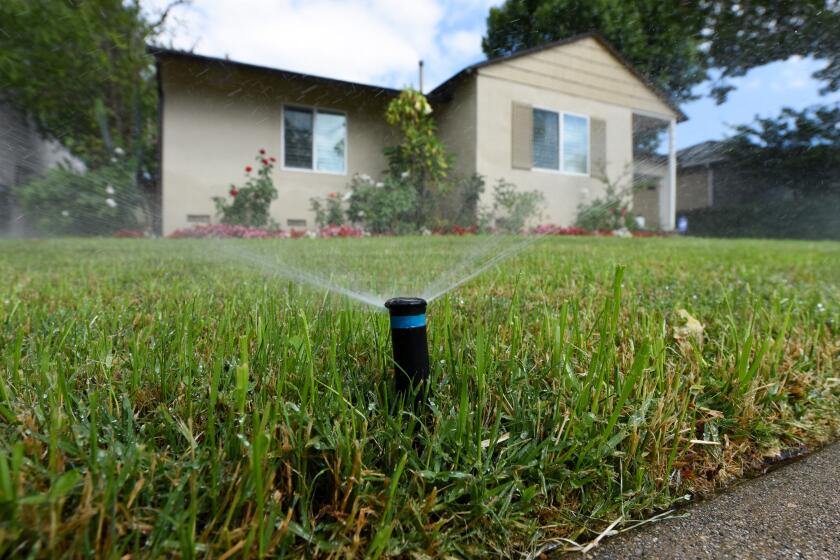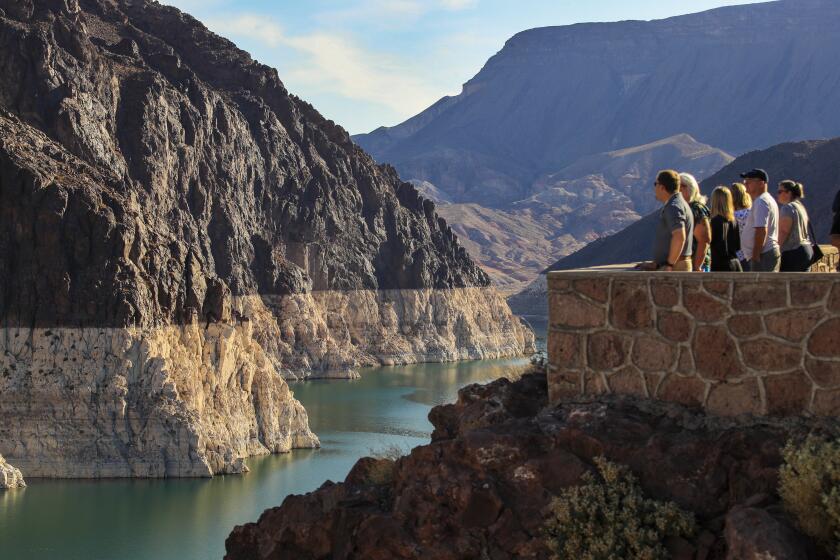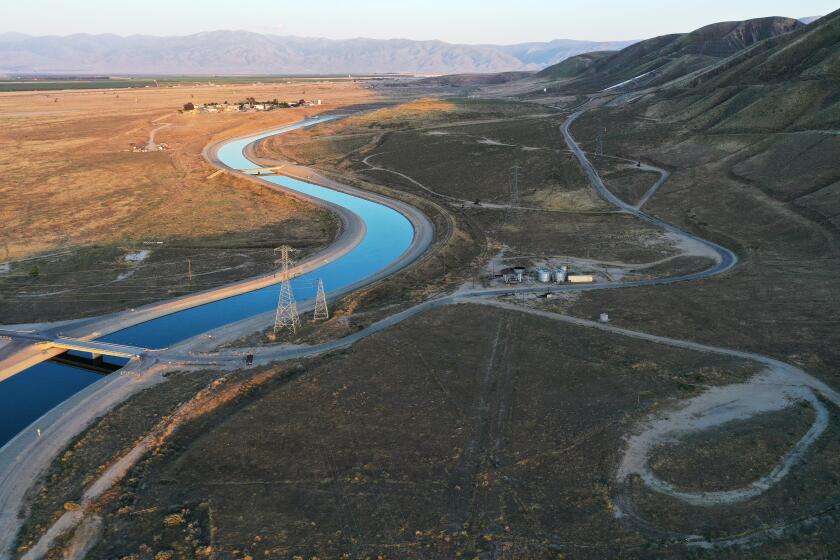California considers $500 fines for water wasters as drought worsens, conservation lags

As California descends deeper into drought, officials are growing increasingly troubled by dwindling water supplies and the public’s lackluster response to calls for conservation, with residents in recent months falling short of Gov. Gavin Newsom’s request for a voluntary 15% reduction in usage.
Now, as the West tips toward crisis, state water regulators are considering adopting emergency regulations that will prohibit certain actions in an attempt to curtail water waste and help conserve supplies.
For the record:
11:14 a.m. Dec. 8, 2021An earlier version of this article said that Los Angeles uses about 7 million acre-feet of water per year. The state of California uses that much water annually, not including for agricultural or environmental purposes.
If approved, the proposal could usher in a wave of water regulations that hearken back to previous droughts while underscoring the seriousness of the current one.
On Tuesday, Lake Mead — the nation’s largest reservoir and a lifeline for water in Los Angeles and the West — was at 1,065 feet, or about 34% of its capacity, a near-historic low. Much of California on the U.S. Drought Monitor map was painted in worrisome shades of red.
“These regulations are kind of no-brainers at this point,” said Doug Parker, director of the California Institute for Water Resources at UC Davis. “They probably should have been done a little while ago.”
Gov. Newsom declared a statewide drought emergency Tuesday, as officials announced that Californians reduced water use an average of 5% in August.
Among the activities that may be prohibited are washing vehicles with hoses that do not have shut-off nozzles; hosing down sidewalks, driveways or patios “except in cases where health and safety are at risk”; watering landscapes in a manner that causes excessive runoff; and watering lawns within 48 hours after measurable rainfall.
For many, the measures feel like déjà vu as California again faces the prospect of dwindling water supplies.
In 2014, then-Gov. Jerry Brown introduced similar bans on watering at the start of an impending drought. Within a year, Brown had instituted mandatory water-use cuts statewide — a move widely seen as successful, with water use dropping by nearly 25%. Amid the cuts, desiccated lawns and shorter showers became commonplace across the region.
“Moving forward with these prohibitions now makes sense,” said Eric Oppenheimer, chief deputy director of the State Water Resources Control Board. “I think it’s the right next step.”
Under the proposed rules, violators could face fines of up to $500 a day. Enforcement would come from cities, counties and local water agencies.
Notably, the regulations would prevent homeowners associations and local governments from taking action against residents who do not comply with landscaping policies, such as those that require lush lawns.
Calling the proposed prohibitions “common-sense measures,” Oppenheimer said the activities under consideration simply “don’t make sense during the drought.”
“I think most people would agree we shouldn’t be watering lawns when it’s raining,” he said.
Water officials from California, Arizona and Nevada are discussing plans to take even less water from the shrinking river and leave it in Lake Mead.
Multiple experts said the new regulations could follow the same pattern as those of the previous drought, leading to further restrictions if conditions do not improve.
“I think it’s a matter of timing, and I think we will be asking more of people beyond this,” Parker said, noting that even a rainy winter may not be enough to end the drought.
The proposed restrictions would save an estimated 100,000 acre-feet of water, but California uses about 7 million acre-feet of water per year, not including for agricultural use or environmental use, he said.
More restrictions are likely, Parker added, but “it’s easier to sort of implement them in stages rather than hit everybody too hard, too fast.”
Yet even incremental restrictions are not always welcome. The latest proposal spells out a potential $100-million revenue loss for state water agencies. Many of those losses trickle down to consumers in the form of surcharges or extra fees, officials said.
In 2016, water suppliers successfully campaigned for the relaxation or removal of Brown’s restrictions after the arrival of rain and snow, with some arguing that a one-size-fits-all approach doesn’t work in a state where regional sources and supplies vary vastly.
The resolution calls on residents to step up conservation efforts, but focuses especially on six water agencies that rely on the State Water Project.
But most California water agencies are on board with the latest proposal, said Dave Eggerton, executive director of the Assn. of California Water Agencies, which represents more than 460 organizations. Eggerton said many local agencies and municipalities have voluntarily implemented some of the proposed standards or taken them even further. Some areas never removed the previous restrictions in the first place.
“Measures like this are pretty straightforward and make sense in this context,” he said.
Officials at the Los Angeles Department of Water and Power said their emergency water conservation plan, first enacted in 1990, includes nearly all of the regulations in the state’s proposal.
“LADWP has a long-standing history of requiring our customers to use water efficiently,” agency spokeswoman Ellen Cheng said.
When asked whether revenue losses would be passed to consumers, Cheng said those who save water should see a reduction in their bills.
While the measures are a logical first step, Eggerton and others said the state needs continued investment in “a full suite of actions” beyond conservation efforts, including the development of water storage systems and conveyance facilities.
“The reality is, the impacts of climate change are here, and we need state and federal partnership in investing, in really strengthening our systems,” he said.
A recent study found that snowpack — one of California’s primary sources of water — could significantly diminish in the state in as little as 35 years.
“We can’t conserve our way out of our challenges,” said Adel Hagekhalil, general manager and chief executive of the Metropolitan Water District of Southern California, which declared a drought emergency in November. “We need bold actions and investments in recycling and reuse, local water supplies, rain-capture systems and storage, remediation and recharge of groundwater basins and projects to build connectivity and flexibility in how we move water.”
New research has found that winters of low snow, or even no snow, could become a regular occurrence in California in as little as 35 years.
In September, Newsom allocated more than $5 billion of his $15-billion climate package toward drought response and water resilience. The governor this year also called on all residents to voluntarily reduce their water usage by 15%, but early results indicated a sluggish response to that request.
Californians in September decreased water use by 3.9% compared with the same month in 2020. The numbers improved in October, with residents saving 13.2% more water than in the same month last year, officials said during a Tuesday meeting of the state water board. But cumulative savings are still far from where they need to be, conservation supervisor Charlotte Ely told the board, adding, “We have to stay vigilant, and we ask for Californians to keep on conserving.”
Ellen Hanak, vice president and director of the Water Policy Center at the Public Policy Institute of California, said voluntary calls to reduce water use this year have been more challenging than in the past — in part because “this time around, people have a lot of other things on their mind besides drought.”
Hanak noted that recent surveys found that the state’s residents are most concerned about the COVID-19 pandemic, housing costs and homelessness, among other issues.
“So if it ends up being the case that this coming year does turn out to be a dry one,” Hanak said, “you can be sure that there’s going to be a lot more public messaging about [the drought] — because there’s going to need to be.”
The state water board is accepting written public comments on the proposed regulations until Dec. 23 and will vote on the measure Jan. 4.
More to Read
Start your day right
Sign up for Essential California for news, features and recommendations from the L.A. Times and beyond in your inbox six days a week.
You may occasionally receive promotional content from the Los Angeles Times.











